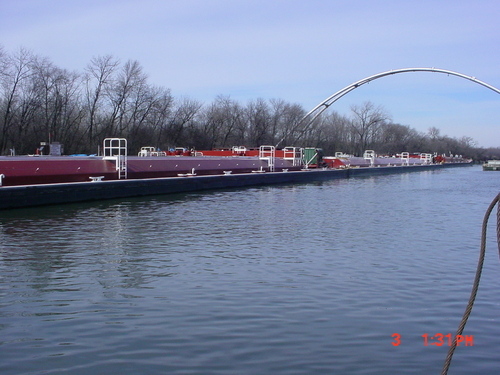
Electric fish barrier in Chicago. Source: U.S. Coast Guard
By Shawntina Phillips
phill465@msu.edu
Oct. 13, 2009
State and federal officials are considering a fish poison as a way of pushing back a front of hungry carp that are advancing toward the Great Lakes.
Recent DNA testing indicates that Asian carp are now within a mile of an electric barrier designed to keep fish out of Lake Michigan. They already have reached the Des Plaines River, a body of water that runs parallel to the barrier.
That’s worrisome said John Rogner, the assistant director of the Illinois Department of Natural Resources.
“The big concern right now is that we know that during flood events that water from the Des Plaines can flow directly into the canal and potentially bypass the barrier in which case [the carp] would be able to gain access to Michigan and the Great Lakes,” Rogner said.
This has prompted state and federal officials to look into the use of a fish poison called rotenone to control the onslaught of carp.
“The use of rotenone on Asian carp approaching the Chicago Sanitary and Ship Canal electrical dispersal barrier as an emergency measure would be particularly useful as a means to push the fish back away from the barrier system,” said Mark Burrows, a physical scientist with the International Joint Commission, a U.S./Canadian organization that advises the governments on Great Lakes issues.
Its use in upcoming routine repairs of the barrier is under consideration, Burrows said.
“The barriers need routine scheduled maintenance which requires a short shutdown of parts of the system without risk of fish getting through,” Burrows said. “A rotenone treatment would remove the fish from the area near [the barrier] so that it could be shut off for a short period and it could be given its required maintenance.”
POLL: Vote on best way to
keep carp out of Lake Michigan
The maintenance would take about 14 hours, but the proposed rotenone treatment would do its job in 8 hours said Phil Moy, a fisheries and aquatic invasive species expert with the Wisconsin Sea Grant. During this time, the rotenone would be applied only around the barrier.
The rotenone would be detoxified using permanganate which would be applied downstream. The rest of the cleanup would entail “picking up dead fish,” Moy explained.
The rotenone would not only kill the Asian carp, but also all other fish species in the area. This cleanup would take about two weeks, and the whole process will cost three quarters of a million dollars, according to Moy. If the proposal is accepted and a permit to use the chemical is granted by the DNR’s Division of Fisheries, Rogner said the rotenone would be applied within the next month or two.
The application of rotenone may also be used to sample the river. The DNR would apply rotenone to a small stretch of the river and “see what turns up,” Rogner explained. This would give officials an idea of the fish density and population.
“We’re very interested right now to confirm if they’re there [in the Des Plaines River], how many there are and where they are,” Rogner said.
Rotenone is classified as toxic class II, moderately hazardous or class III, slightly hazardous by the World Health Organization. In some studies, rotenone has been found to cause Parkinson’s-like symptoms when injected into rats. However, Barrows says there’s nothing to worry about.
“Rotenone is not harmful to humans and can be easily neutralized,” he said.
Moy agreed, saying such chemicals must adhere to strict guidelines.
Because carp are bottom-feeders, they were imported from Asia to clean soiled waters. Asian carp were introduced to waters near the Great Lakes when they escaped in the Mississippi River from southern aquaculture facilities during flooding. The fish have steadily made their way northward, competing with native species for resources.
Certain species of Asian Carp can get up to 100 pounds and eat non-stop. One fish can carry up to 5 millions eggs. This threatens natural species because carp can reproduce much more quickly than they can. Carp also jump out of the water when exposed to the sound of motors, endangering recreational boaters.
Carol Swinehart, a specialist in aquatic invasive species for the Sea Grant program, agrees that carp in the Great Lakes would be devastating; however she says officials need to tread carefully.
“It’s a matter of proceeding with all due caution and having to make judgments about what you may sacrifice in a short term to accomplish something larger in the long term,” Swinehart said. “But always with an eye to those unintended consequences.”
Related story: Physical barrier considered for carp control
Great Lakes Echo reporters cover the environment